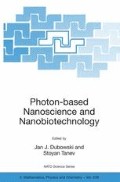Abstract
To address some of the technological problems related to the proposed a novel approach based on the application of arrays of epitaxial quantum dots (eQD) that have been known for their applications in application of colloidal semiconductor nanocrystals for biosensing, we have advanced communication devices such as quantum dot lasers.
Access this chapter
Tax calculation will be finalised at checkout
Purchases are for personal use only
Preview
Unable to display preview. Download preview PDF.
References
M. Bruchez, M. Moronne, P. Gin et al., “Semiconductor nanocrystals as fluorescent biological labels,” Science 281(5385), 2013–2016 (1998).
P. Mitchell, “Turning the spotlight on cellular imaging – Advances in imaging are enabling researchers to track more accurately the localization of macromolecules in cells,” Nature Biotechnology 19(11), 1013–1017 (2001).
Tuan Vo-Dinh, Biomedical photonics handbook, CRC Press, Boca Raton, Fla., 2003.
Sungchul Hohng and Taekjip Ha, “Near-Complete Suppression of Quantum Dot Blinking in Ambient Conditions,” J. Am. Chem. Soc. 126(5), 1324–1325 (2004).
I. L. Medintz, A. R. Clapp, H. Mattoussi et al., “Self-assembled nanoscale biosensors based on quantum dot FRET donors,” Nature Materials 2(9), 630–638 (2003).
P. J. Poole, R. L. Williams, J. Lefebvre et al., “Using As/P exchange processes to modify InAs/InP quantum dots,” Journal of Crystal Growth 257(1–2), 89–96 (2003).
R. L. Williams, G. C. Aers, J. Lefebvre et al., “Quantum dot site-selection using in situ prepared nano-templates,” Physica E-Low-Dimensional Systems & Nanostructures 13 (2–4), 1200–1203 (2002).
J. Lefebvre, P. J. Poole, G. C. Aers et al., “Tunable emission from InAs quantum dots on InP nanotemplates,” Journal of Vacuum Science & Technology B 20(5), 2173–2176 (2002).
A. Passaseo, G. Maruccio, M. De Vittorio et al., “Dependence of the emission wavelength on the internal electric field in quantum-dot laser structures grown by metal-organic chemical-vapor deposition,” Appl. Phys. Lett. 79(10), 1435–1437 (2001).
Klaus Adlkofer, Eric F. Duijs, Frank Findeis et al., “Enhancement of photoluminescence from near-surface quantum dots by suppression of surface state density,” Phys. Chem. Chem. Phys. 4, 785–790 (2002).
Kh. Moumanis, X. Ding, J.J. Dubowski et al., “Aging and detergent wasing effects of the surface of (001) and (110) GaAs passivated with hexadecanethiol,” J. Appl. Phys., in print (2006).
J.J. Dubowski, M. Julier, G.I. Sproule et al., “Laser-assisted dry etching ablation for microstructuring of III-V semiconductors,” Mat. Res. Soc. Symp. Proc. 397, 509–518 (1996).
J. J. Dubowski, B. E. Rosenquist, D. J. Lockwood et al., “Structure damage in reactiveion and laser etched lnP/GalnAs microstructures,” J. Appl. Phys. 78(3), 1488–1491 (1995).
J. J. Dubowski, Y. Feng, P. J. Poole et al., “Monolithic multiple wavelength ridge waveguide laser array fabricated by Nd:YAG laser-induced quantum well intermixing,” J. Vac. Sci. Technol. A. 20(4), 1426–1429 (2002).
J. J. Dubowski, C. N. Allen, and S. Fafard, “Laser-induced InAs/GaAs quantum dot intermixing,” Appl. Phys. Lett. 77(22), 3583–3585 (2000).
Patrick Vermette, Thomas Gengenbach, Upulie Divisekera et al., “Immobilization and surface characterization of NeutrAvidin biotin-binding protein on different hydrogel interlayers,” J. Coll. Int. Sci. 259, 13–26 (2003).
Xiaodi Su, Ying-Ju Wu, Rudolf Robelek et al., “Surface Plasmon Resonance Spectroscopy and Quartz Crystal Microbalance Study of Streptavidin Film Structure Effects on Biotinylated DNA Assembly and Target DNA Hybridization,” Langmuir 21 (1), 348–353 (2005).
J. Ladd, C. Boozer, Q. M. Yu et al., “DNA-directed protein immobilization on mixed self-assembled monolayers via a Streptavidin bridge,” Langmuir 20(19), 8090–8095 (2004).
Tom T. Huang, Jennifer Sturgis, Rafael Gomez et al., “Composite Surface for Blocking Bacterial Adsorption on Protein Biochips,” Biotech. Bioeng. 81(5), 618–624 (2003).
Reid N. Orth, T.G. Clark, and H.G. Craighead, “Avidin-biotin micropatterning methods for biosensor applications,” Biomedical Microdevices 5:1, 29–34 (2003).
Ting Hou, C. Michael Greenlief, Steven W. Keller et al., “Passivation of GaAs (100) with an Adhesion Promoting Self-Assembled Monolayer,” Chem. Mater. 9(12), 3181–3186 (1997).
Fazila Seker, Kathleen Meeker, Thomas F. Kuech et al., “Surface Chemistry of Prototypical Bulk II-VI and III-V Semiconductors and Implications for Chemical Sensing,” Chem. Rev. 100, 2505–2536 (2000).
Ximing Ding, Khalid Moumanis, Jan J. Dubowski et al., “Fourier-transform infrared and photoluminescence spectroscopies of self-assembled monolayers of long-chain thiols on (001) GaAs,” J. Appl. Phys. 99(5), 54701 (2006).
O. Voznyy and J. J. Dubowski, “Structure, bonding nature and binding energy of alkanethiolate on As-rich GaAs (001) surface: a density functional theory study,” J. Phys. Chem. B, submitted (2006).
G. Marshall, private communication, 2006.
Hong Xing You and Christopher R. Lowe, “AFM Studies of Protein Adsorption: 2. Characterization of Immunoglobulin G Adsorption by Detergent Washing,” J. Coll. Int. Sci. 182, 586–601 (1996).
William A. Goddard, Donald W. Brenner, Sergey E. Lyshevski et al., CRC Press, Boca Raton, Fla., 2003.
X. Ding, Kh. Moumanis, J.J. Dubowski et al., “Immobilization of avidin on (001) GaAs surface,” Appl. Phys. A 83(3), 357–360 (2006).
J. Christopher Love, Lara A. Estroff, Jennah K. Kriebel et al., “Self-Assembled Monolayers of Thiolates on Metals as a Form of Nanotechnology,” Chem. Rev. 105(4), 1103–1169 (2005).
Michael Riepl, Mattias Ostblom, Ingemar Lundstrom et al., “Molecular Gradients: An Efficient Approach for Optimizing the Surface Properties of Biomaterials and Biochips,” Langmuir 21(3), 1042 (2005).
X. Ding, Kh. Moumanis, J.J. Dubowski et al., “A study of binding biotinylated nanobeads to the surface of (001) GaAs,” SPIE Conf. Proc. Vol. 6106, L1–L7 (2006).
Author information
Authors and Affiliations
Editor information
Editors and Affiliations
Rights and permissions
Copyright information
© 2006 Springer
About this paper
Cite this paper
DUBOWSKI, J.J. (2006). QUANTUM DOT BIO-TEMPLATE FOR RAPID DETECTION OF PATHOGENIC SUBSTANCES. In: Dubowski, J.J., Tanev, S. (eds) Photon-based Nanoscience and Nanobiotechnology. NATO Science Series, vol 239. Springer, Dordrecht. https://doi.org/10.1007/978-1-4020-5523-2_7
Download citation
DOI: https://doi.org/10.1007/978-1-4020-5523-2_7
Publisher Name: Springer, Dordrecht
Print ISBN: 978-1-4020-5521-8
Online ISBN: 978-1-4020-5523-2
eBook Packages: Chemistry and Materials ScienceChemistry and Material Science (R0)

